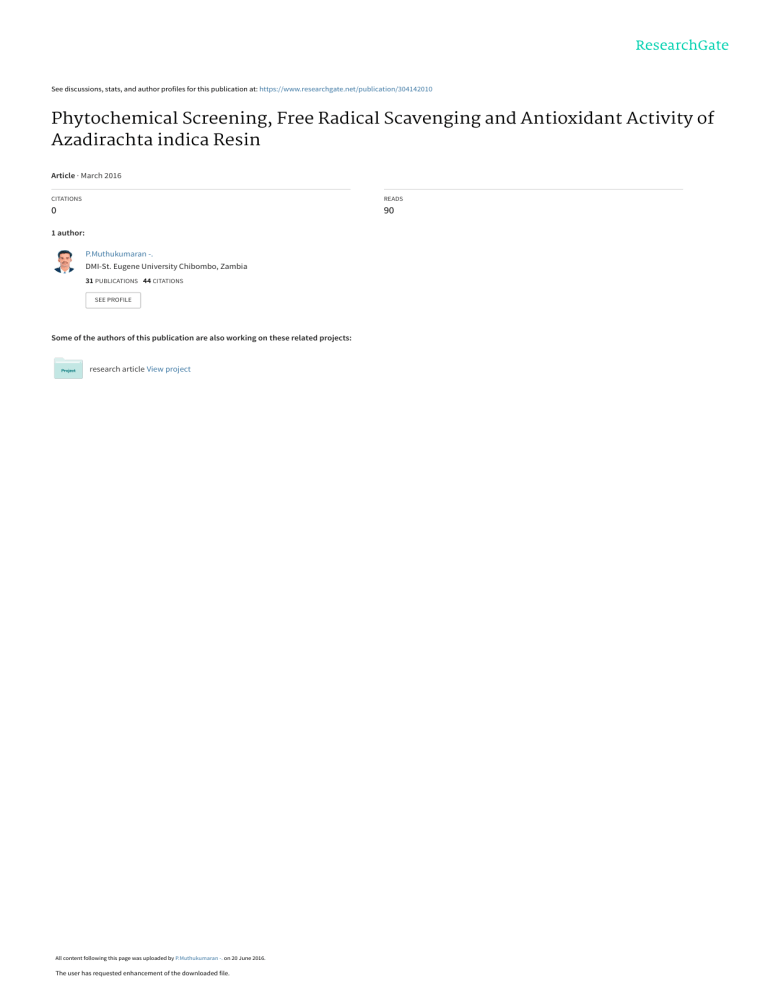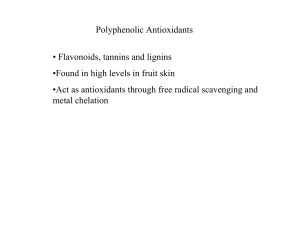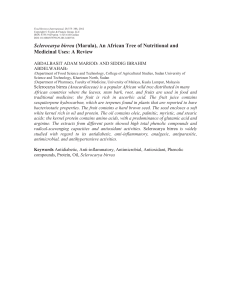06-4463P.MUTHUKUMARAN2
advertisement

See discussions, stats, and author profiles for this publication at: https://www.researchgate.net/publication/304142010 Phytochemical Screening, Free Radical Scavenging and Antioxidant Activity of Azadirachta indica Resin Article · March 2016 CITATIONS READS 0 90 1 author: P.Muthukumaran -. DMI-St. Eugene University Chibombo, Zambia 31 PUBLICATIONS 44 CITATIONS SEE PROFILE Some of the authors of this publication are also working on these related projects: research article View project All content following this page was uploaded by P.Muthukumaran -. on 20 June 2016. The user has requested enhancement of the downloaded file. 450 in Biosciences 9(7), Print : ISSN 0974-8431, Trends Trends 450-455, in Biosciences 2016 9 (7), 2016 Phytochemical Screening, Free Radical Scavenging and Antioxidant Activity of Azadirachta indica Resin P. MUTHUKUMARAN AND S.KUMARAVEL Indian Institute of Crop Processing Technology, Thanjavur, Tamilnadu 613005 ABSTRACT The aim of this study was to investigate the Phytochemical and antioxidant effect of Azadirachta Indica Resin. The antioxidant activity was evaluated by various antioxidant assays, including 1, 1-diphenyl2- picrylhydrazyl (DPPH), 2, 2’-azino-bis (3ethylbenzthiazoline-6-sulfonic acid) (ABTS), and Hydrogen peroxide scavenging method. The antioxidant activities were compared to standard antioxidant ascorbic acid. Azadirachta Indica Resin extract showed a significant antioxidant activity in DPPH, ABTS and H2O2 scavenging methods. The findings of the present study suggest that Azadirachta Indica Resin could be a potential source of natural antioxidant that could have greater importance as therapeutic agent in preventing or slowing oxidative stress related degenerative diseases. Key words DPPH, ABTS ,H 2O 2, Azadirachta Indica,Resin Medicinal plants show antioxidant property is used to prevent oxidative damage caused by free radicals (Maxwell, 1995). Reactive oxygen species (ROS) are consisting of free radicals (O2, HO) and non free radicals (H2O2). Free radicals produced from oxidation reaction start the chain reaction that damage the cell get involved in immune suppression, cell membrane disintegration, membrane protein damage and DNA mutation, which can further initiate the development of many diseases like cancer, liver injury, cardiovascular diseases, inflammation, diabetes, atherosclerosis etc (Devasagayam et al .,2004). The most reactive free radical is the hydroxyl radical which is known to initiate lipid peroxidation and cause fragmentation of DNA leading to mutations(Haillwell, 1997).Although the body possesses such defense mechanisms as enzymes and antioxidant nutrients, which arrest the damaging properties by removing, free radical intermediates and inhibit other oxidation reactions. Many antioxidant compounds, naturally occurring from plant sources, have been identified oxygen scavengers (Duh, 1998). Recently, interest has increased considerably in finding naturally occurring antioxidant for use in foods or medicinal materials to replace synthetic antioxidants, which are being restricted due to their side effects such as carcinogenicity. Natural antioxidants can protect the human body from free radicals and retard the progress of many chronic diseases as well as retard lipid oxidative rancidity in foods (Lai et al .,2001). Azadirachtaindica Commonly known as Neem is widely distributed in Indian subcontinent and its neighbouring countries for more than a thousand years as one of the most versatile medicinal plant having wide spectrum biological activity. It has been an inherent part of folklore and the traditional medicinal system since one can recall. Every part of the tree is used as medicine for household remedies against various human ailments and even as bio-pesticides for agricultural purpose. Tender shoots and leaves are taken as food in India; in Assam the tiny leaves were oil fried to eat with the rice in early summer like in the month of MarchApril, which function as an appetizer. The twigs are often used to clean the teeth.Neem oil, leaves, bark, stem products have been therapeutically used for the treatment of respiratory disorder, inflammation, constipation, skin infection (Sithisarn et al., 2006 ) arthritic disorders, fever and diabetes etc (Van Der Nat et al., 1992) . The present study was thus undertaken to access the antioxidant activity of Azadirachtaindica Resin using DPPH radical scavenging ABTS and H 2O2 Scavenging assay. Collection and Preparation of Extracts Azadirachtaindica resin collected from Thanjavur, Tamilnadu, India. The resins were then dried under shade 15 days. The dried resins was coarsely powdered and used for following estimations. MUTHUKUMARAN and KUMARAVEL, Phytochemical Screening, Free Radical Scavenging and Antioxidant Activity 451 Fig. 1. Phytochemical quantification 25 g of air dried powder of resins were taken separately with 150 ml of Ethanol and were soaked for 24 hrs till the colour of the plant material disappeared. After which the extracts were collected and stored at 4oC in airtight bottles and were qualitatively tested for the presence of various phytocompounds. Total polyphenolic content (TPC) Total polyphenol content (soluble and bound) was determined by the method described by Singleton and Rossi (1965) .Known volume of extract was taken and made up to 250µl with distilled water and the sample was mixed with 250 µl of folinciocalteau reagent and 500 µl of 20% Na 2Co3. The final reaction mixture volume was adjusted to 5ml using distilled water. The reaction mixture was incubated in dark for 30 minutes and samples were then centrifuged at 2000 rpm for 5 minutes after which the supernatant absorbance Fig. 2. DPPH S cavenging Activity 452 Trends in Biosciences 9 (7), 2016 Fig. 3. Hydrogen Peroxide Scavenging Activity was measured at 760 nm. A calibration curve was constructed with different concentrations of gallic acid as standard. The results were expressed as mg of gallic acid equivalent/100g of sample. Total flavonoids content This was assayed as described by Jia et al.,(1999) with slight modification. A known amount of above mentioned extract was taken and made up to 500µl with distilled water. To this mixture 75µl of 5% sodium nitrite was added and allowed to stand for 5 minutes after which 150 µl of 10% AlCl3 was added and after 6 minutes 0.5 ml of 1M NaOH were added and sample mixture was incubated at dark for 15 minutes. It was then centrifuged at 2500 rpm for 5 minutes and absorbance was recorded at 512nm. The flavanoid content was expressed as mg of catechin equivalent/100g of sample. Fig. 4. Reducing Power MUTHUKUMARAN and KUMARAVEL, Phytochemical Screening, Free Radical Scavenging and Antioxidant Activity 453 Total Tannins content scavenging activity was calculated by the formula: The quantitative tannin content in samples was estimated by the method of Price and Butler (1977), with some modifications. Known concentration of methanolic extract were taken and made up to 0.5ml using distilled water. To this reaction mixture, 1 ml 1% K3Fe(CN)6 and 1ml 1% FeCl3 were added, and the volume was made up to 10 ml with distilled water. The reading of the resultant solution was measured spectrophotometrically at 720nm after 5 min using tannic acid as a standard. The tannin content was expressed as mg of tannic acid equivalent/100g of sample. DPPH Radical Scavenging assay Accurately weighed 4.3 mg of DPPH was dissolved in 3.3 ml of methanol in a test tube (Ionita., 2005). Solution was protected from light by covering with aluminum foil. 150 ìl of above solution was taken and diluted up to 3 ml with methanol, the absorbance of this solution was taken immediately at 516 nm on UV spectrophotometer using methanol as blank. This reading was served as control reading. For the test and standard, the aliquots of different concentration ranging were prepared. For the assay 150 ìl of the test or std solution was added to 150 ìl of DPPH solution and diluted up to 3 ml with methanol, the absorbance of this solution was taken after 15 min at 516 nm on UV spectrophotometer using methanol as blank. The absorbance was taken in triplicate manner. The % Scavenging activity was found by using following formula: O.D of control – O.D of test % scavenging activity = ——————— × 100 O.D of control Hydroxyl Radical Scavenging Activity The Hydroxyl radical scavenging activity was measured by studying the competition between deoxyribose and the extract for hydroxyl radicals generated from the Fe3+/ascorbate/ EDTA/ H2O2 system (Jayaprakasha et al .,2004). The reaction mixture contained deoxy ribose (2-8mM), Fecl (0.1mM), EDTA (0.1mM), H2O2 (lmM), ascorbate (0.1mM), KH PO - KOH buffer (20mM, 2 4 pH 7.4) and various concentrations (25- 400 ìm of extracts and std 10 to 80 ìm /ml) of standard drug in a final volume of 1 ml. The reaction mixture was incubated for 1hr at 37°C; deoxyribose degradation was measured with spectrophotometer at 532 nm. The percentage of hydroxyl radical O.D of control – O.D of test % scavenging activity = ——————— × 100 O.D of control Reducing power The reducing power of a compound serves as significant indicator of its potential antioxidant activity. Increased absorbance of the reaction mixture indicates increased reducing power. Various conc. of the extracts in 1ml of water were mixed with phosphate buffer (2.5 ml, 0.2 M pH 6.6) and 1% potassium ferricyanide (2.5 ml). The mixture was incubated at 50ºC for 20 min. Aliquots of trichloroacetic acid (2.5 ml, 10%) were added to the mixture, which was then centrifuged al 3000g for 10 min. upper layer of solution (2.5 ml) was mixed with distilled water (2.5 ml) and freshly prepared FeCl 3 solution (0.5ml, 0.1%). The absorbance was measured at 700nm (Oyaizu ,1986). Control – Test Reducing power formation (%) = ———— X100 Test Statistical analysis All experiments were performed thrice and the results averaged Data were expressed as Mean ± SD RESULTS AND DISCUSSION The phytochemicals are the most prevalent secondary metabolites in the plant kingdom. They are naturally occurring antioxidant components and are capable of mitigating the harmful effects of diseases related to oxidative stress (Li et al., 2008). Quantification constituents of phytochemical The Quantified Phenolic contents of Azadirachta Indica Resin extracts were 19.40 (mg/ 100g GAE), The Flavonoid content 19.14 (mg/100g GAE), Tannic acid 30.8 (mg/100g). Results of quantified Phenol, Flavonoids and Tannic acid contents were showed in Figure 1. Chemical compounds from plants are known to be useful in the treatment of many diseases(Cheenpracha et al., 2010). Phenolic compounds used as nutraceuticals, and found in apples, green-tea, and red-wine and 454 Trends in Biosciences 9 (7), 2016 in many medicinal plants as phytochemical or secondary metabolites. Phenolic compound has enormous ability to combat cancer and are also thought to prevent heart ailments to an appreciable degree and sometimes are anti-inflammatory agents. They are potent vasodilator (Padilla et al., 2005) and for the presence of hydroxyl group they possessing potent scavenging activity (Rajan and Muthukrishnana.,2013). The Resin showed considerably high amount of phenolic content (75.39 ± 3.19 mg/g). The detection and quantification of total phenolic compound present in the Resin of Azadirachta Indica Resin may in future contribute in field of herbal remedy as potent antioxidant. DPPH activity. In this study, at 50ìg /ml, the resin extract showed highest inhibition of DPPH activity shown in (Figure 2). The experimental data of the extracts revealed that the extracts are likely to have the effects of scavenging free radicals. From the result we observe that a dose dependent relationship in the DPPH radical scavenging activity. The involvement of free radicals, especially their increased production, appears to be a feature of most of the human diseases including cardiovascular diseases and cancer (Deighton et al., 2000). The results of DPPH-free radical scavenging assay suggest that the Azadirachta Indica Resin is more capable of scavenging free radicals. Flavonoids are important group of polyphenol widely distributed among the plant flora and containing a benzopyrone which use as antioxidants or free radical scavengers and also have cardio protective roll (Kar, 2007). By inhibiting the estrogen producing enzyme Flavonoid suppress the progression of cancer. For example, Flavonoid inhibited the estrogen synthesis which binds estrogen to its receptor. The percentage of total Flavonoid in Azadirachta Indica Resin was (19.14 mg/100g GAE). This moderately the level of Flavonoid present in the Resin could be attributed to its antioxidant capacity. Hydrogen peroxide Tannin is Phenolic compounds of high molecular weight used as antiseptic and this activity is due to presence of the Phenolic group. This is also associated with antiviral activity. In presence of very high quantity of tannin, there are many viruses like polio virus, herpes simplex viruses have been found to get inactivated (Bajaj, 1998). The Resin of Azadirachta Indica contains very high level of tannin (30.8 mg/100g). The presence of very high quantity of tannin supports the Resin of this plant has antimicrobial activity. DPPH radical Scavenging assay In the present study several free radical scavenging activities of ethanolic extract of Azadirachta Indica Resin were evaluated by DPPH scavenging assay. Ethanolic extracts of Resin have got profound antioxidant activity. DPPH antioxidant assay is based on the ability of DPPH, a stable free radical, which gets decolorized in the presence of antioxidants (Burits and Bucar ,2000). 19) . The ethanolic extracts of Azadirachta Indica Resin exhibited a significant dose dependent inhibition of Hydrogen peroxide itself is not very reactive, but sometimes is toxic to cell because it may give rise to hydroxyl radical in the cells (Halliwell, 1991). Therefore, removing of hydrogen peroxide is very important for antioxidant defense in cell system. In this study, at 50ìg /ml, the resin extract showed highest inhibition of H2O2 activity shown in (Figure 3). The composition of hydrogen peroxide into water may occur according to the antioxidant compounds as the antioxidant components present in the extract are good electron donors, they may accelerate the conversion of H 2 O 2 to H 2 O. Polyphenols have also been shown to protect mammalian cells from damage induced by hydrogen peroxide, especially compounds with the orthohydroxy Phenolic compounds like Quercetin, Gallic acid, Caffeic acid and catechin (Nakayama ,1994). Therefore, the Phenolic compounds of the Phenol of Azadirachta Indica Resin may probably be involved in scavenging hydrogen peroxide. The reducing capacity The reducing capacity of a biological compound acts as a significant indicator of its antioxidant potential (Moein et al., 2008) .The reducing properties are generally associated with the presence of reductones. Reductones are also reported to react with certain precursors of peroxide, thus preventing peroxide formation. Figure 4 shows the reductive capabilities of the Azadirachta indica resin compared to ascorbic acid. Higher ascorbic acid equivalent value indicates higher reducing capacity of samples, thus greater antioxidant potential. The Azadirachta indica resin with potent reducing capacity. The reducing power MUTHUKUMARAN and KUMARAVEL, Phytochemical Screening, Free Radical Scavenging and Antioxidant Activity 455 of ethanolic extract of Azadirachta indica resin was found remarkable and the reducing power of the extract was observed to rise as the concentration of the extract gradually increased. The result of scavenging activity assay in this study indicates that the resin was potently active. This suggests that the resin contain compounds that are capable of donating hydrogen to a free radical in order to remove odd electron which is responsible for radical’s reactivity. The extracts were capable of scavenging DPPH, hydroxyl and Reducing Power activity in a concentration dependent manner. Further investigation of the compounds responsible for the antioxidant activity, its isolation and in vivo studies are needed. LITERATURE CITED Bajaj YPS. 1988 .Medicinal and aromatic plants (Biotechnology in agriculture and forestry). B er lin : Springer-Verlag. Burits, M., Bucar, F.2000. Antioxidant activity of Nigella sativa essential oil. Phytotherapy Research, 14:323– 328. Cheenpracha S, Park EJ, Yoshida WY, Barit C, Wall M, Pezzuto JM .2010. Potential anti-inflammatory phenolic glycosides from the medicinal plant Moringa oleifera fruits. Bioorg Med Chem , 18(17): 6598-6602. Deighton N, Brennan R, Finn C, Davies HV.2000. Antioxidant properties of domesticated and wild Rubus species. J. Sci. Food Agric, 80; 1307-1313. Devasagayam T.P.A, Tilak J.C., Boloor K.K., Sane K.S., Ghaskadbi S.S and.Lele R.D .2004. Review: Free radicals and antioxidants in human health: Current status and future prospects, J. Assoc. Phys. India, ,52, 794-804. Duh P D .1998.Antioxidant activity of burdock (Arctium lappa Linne): Its scavenging effect on free radical and active oxygen, Journal of the American Oil Chemist’s Society, 75: 455– 465 Haillwell.B.1997. Oxygen Radicals and Disease Process (Hardwood Academic Publisher, The Netherlands, , 114. Halliwell B .1991. Reactive oxygen species in living systems: Source biochemistry and role in human disease. Am J Med; 91 Suppl., 14–22. Ionita P .2005. Is DPPH Stable free radical a good scavenger for oxygen active species? Chem., 59, 11-6. Jayaprakasha GK, Jaganmohan RL, Sakariah KK (2004). “Antioxidant activities of flavidin in different in vitro model systems.” Bioorg. Med. Chem. 12(19):5141-5146. Jia, Z.S., Tang, M.C and Wu J.M (1999).The determination of Flavonoid contents in mulberry and their scavenging effects on superoxide radicals,”Food Chem, 64 (4): 555559. Kar, A (2007). Pharmaocgnosy and Pharmacobiotechnology (Revised-Expanded Second Edition). New Delhi: New Age International LimtedPublishres, 332-600. Lai L.S., Chou S.T., Chao W.W(2001).Studies on the antioxidativeactivities of hsian-tsao (Mesona procumbens Hemsl) leaf gum, Journal of Agricultural and Food Chemistry, 49: 963–968. Li HB, Wong CC, Cheng KW, Chen F (2008). Antioxidant properties in vitro and total phenolic contents in methanol extracts from medicinal plants. LWTF ood Sci Technol 41: 385-390. Maxwell SRJ (1995). Prospects for the use of antioxidant therapies. Drugs, 45: 345-361. Moein MR, Moein S, Ahmadizadeh S (2008). Radical scavenging and reducing power of Salvia mirzayanii Subfractions. Molecules 13:2804-2813. Nakayama T (1994).Suppression of hydroperoxide-induced cytotoxicity by polyphenols. Cancer Res, 54; 19911993. Oyaizu, M. 1986 Studies on product of browning reaction prepared from glucose amine. Japanese Journal of Nutrition 44: 307-315, Padilla E, Ruiz E, Redondo S, Gordillo-Moscoso A, Slowing K, Tejerina T(2005) Relationship between vasodilation capacity and phenolic content of Spanish wines. Eur J Pharmacol. 517(1-2):84–91. Price, M.L and Butler, L.G (1977) Rapid visual estimation and spectrophotometric determination of tannin content of sorghum grain,”J Agricul Food Chem,vol: 25 (6), 12681273. Rajan T, Muthukrishnana S (2013). Characterization of phenolic compounds in pseudarthria viscida root extract by hplc and ft-ir analysis. Asian J Pharm Clin Res , 6(2): 274-276. Singleton, V.L and Rossi, J.A (1965).Colorimetry of total phenolics with phosphomolybdicphosphotungstic acid reagent,” Am J Enol Viticult, 16 (3), 144-158. Sithisarn P., Supabphol R., andGritsanapan W (2006).Internat. Jr. of the Kuwait University Health Sciences Centre, 15, 3. Van Der Nat, M. G., Van Der Sluis, K. and Labadie, R. P (1991).Biological activities and medicinal properties of neem (Azadirachta indica). J Ethnopharmacol., 35,1– 24. Received on 17-03-2016 View publication stats Accepted on 20-03-2016



